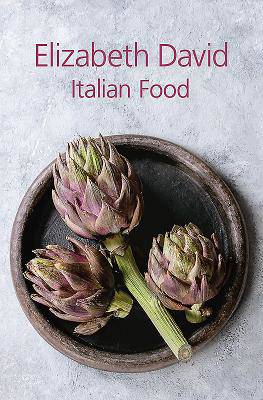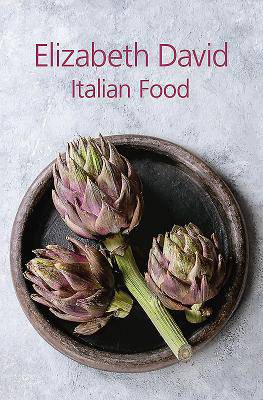
- Retrait gratuit dans votre magasin Club
- 7.000.000 titres dans notre catalogue
- Payer en toute sécurité
- Toujours un magasin près de chez vous
- Retrait gratuit dans votre magasin Club
- 7.000.000 titres dans notre catalogue
- Payer en toute sécurité
- Toujours un magasin près de chez vous
Description
This is a critical and analytical look at Italian food, organized by type of dish rather than by region and is full of details of kitchens and cooking by painters from the 14th, 15th and 18th centuries.
Jane Grigson wrote of Italian Food 'Basil was no more than the name of bachelor uncles, courgette was printed in italics as an alien word, and few of us knew how to eat spaghetti or pick a globe artichoke to pieces. ... Then came Elizabeth David like sunshine, writing with brief elegance about good food, that is, about food well contrived, well cooked. She made us understand that we could do better with what we had.'
Published in 1954 the importance of this book, which required a full year's research in Italy, can only be appreciated when you realize that she was working in a post-rationing England which regarded Italian cuisine as nothing more than variations on pasta and veal. What she discovered was an enormous wealth of regional diversity in ingredients, methods, and even language, where the same pasta shape can be called three or four names in different parts of the country. She understood that all Italian cooking is regional; there is no 'national' cuisine and so there are eight recipes for aubergines, fourteen for artichokes, five for fennel and seven for lentils, all from different regions. But if such descriptions seem to today's reader overly thorough it is because many of her 1950's audience would have never heard of risotto, gorgonzola, prosciutto or even olive oil, let alone been able to purchase them.
This is a critical and analytical look at Italian food - her personality and point of view come out on almost every page - organized by type of dish rather than by region and is full of details of kitchens and cooking by painters from the 14th, 15th and 18th centuries. The book is filled with asides and quotes from Italian writers and thinkers and as confirmation that this is more a work of scholarship than a simple book on cookery, there are appendices of bibliographies and notes on wine.
If you want to explore the authentic regional roots of the Italian kitchen, Elizabeth David's masterpiece is the place to start. And the joy and relevance of this book today is that recipes that could only be read 60 years ago can now be cooked and savored.
Elizabeth David's acclaimed writings are often cited as an inspiration by many of today's leading chefs, as well as home cooks, and are essential to any serious cookery book collection.
Jane Grigson wrote of Italian Food 'Basil was no more than the name of bachelor uncles, courgette was printed in italics as an alien word, and few of us knew how to eat spaghetti or pick a globe artichoke to pieces. ... Then came Elizabeth David like sunshine, writing with brief elegance about good food, that is, about food well contrived, well cooked. She made us understand that we could do better with what we had.'
Published in 1954 the importance of this book, which required a full year's research in Italy, can only be appreciated when you realize that she was working in a post-rationing England which regarded Italian cuisine as nothing more than variations on pasta and veal. What she discovered was an enormous wealth of regional diversity in ingredients, methods, and even language, where the same pasta shape can be called three or four names in different parts of the country. She understood that all Italian cooking is regional; there is no 'national' cuisine and so there are eight recipes for aubergines, fourteen for artichokes, five for fennel and seven for lentils, all from different regions. But if such descriptions seem to today's reader overly thorough it is because many of her 1950's audience would have never heard of risotto, gorgonzola, prosciutto or even olive oil, let alone been able to purchase them.
This is a critical and analytical look at Italian food - her personality and point of view come out on almost every page - organized by type of dish rather than by region and is full of details of kitchens and cooking by painters from the 14th, 15th and 18th centuries. The book is filled with asides and quotes from Italian writers and thinkers and as confirmation that this is more a work of scholarship than a simple book on cookery, there are appendices of bibliographies and notes on wine.
If you want to explore the authentic regional roots of the Italian kitchen, Elizabeth David's masterpiece is the place to start. And the joy and relevance of this book today is that recipes that could only be read 60 years ago can now be cooked and savored.
Elizabeth David's acclaimed writings are often cited as an inspiration by many of today's leading chefs, as well as home cooks, and are essential to any serious cookery book collection.
Spécifications
Parties prenantes
- Auteur(s) :
- Editeur:
Contenu
- Nombre de pages :
- 406
- Langue:
- Anglais
Caractéristiques
- EAN:
- 9781911621294
- Date de parution :
- 16-05-19
- Format:
- Livre relié
- Format numérique:
- Genaaid
- Dimensions :
- 127 mm x 203 mm
- Poids :
- 544 g







